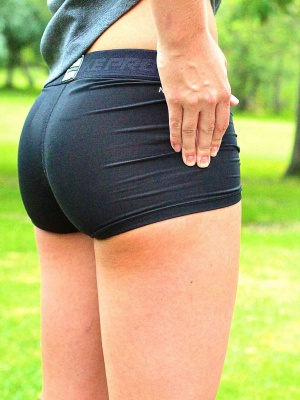Gluteal Tendinopathy: Difference between revisions
(Added new title and image) |
No edit summary |
||
| Line 7: | Line 7: | ||
== Introduction == | == Introduction == | ||
Gluteal Tendinopathy (GT) is defined as moderate to sever disabling pain over the Greater Trochanter (lateral hip pain). It is often referred to as Greater Trochanter Pain Syndrome (GTPS) and was traditionally diagnosed as [[Trochanteric Bursitis]], however, recent research defines non-inflammatory [[tendinopathy]] of the gluteus medius and/or gluteus minimus muscles to be the main source of lateral hip pain<ref name=":0">Grimaldi A, Mellor R, Hodges P, Bennell K, Wajswelner H, Vicenzino B. Gluteal tendinopathy: a review of mechanisms, assessment and management. Sports Medicine. 2015 Aug 1;45(8):1107-19.</ref>. | |||
This condition affects both athletes (particularly runners) and less active people<ref name=":0" />. One of four females over 50 years is likely to be affected by GT<ref>Mellor, R., Bennell, K., Grimaldi, A., Nicolson, P., Kasza, J., Hodges, P., Wajswelner, H. and Vicenzino, B., 2018. Education plus exercise versus corticosteroid injection use versus a wait and see approach on global outcome and pain from gluteal tendinopathy: prospective, single blinded, randomised clinical trial. ''bmj'', ''361'', p.k1662.</ref>. | |||
Gluteal Tendinopathy (GT) has significant impacts on the quality of life, it interferes with sleep (side lying) and common weight bearing tasks<ref name=":0" />. | |||
== Clinically Relevant Anatomy<br> == | == Clinically Relevant Anatomy<br> == | ||
<br> | |||
== Mechanism of Injury / Pathological Process<br> == | == Mechanism of Injury / Pathological Process<br> == | ||
| Line 19: | Line 23: | ||
== Clinical Presentation == | == Clinical Presentation == | ||
Studies using various scales rate it as a cause of moderate to | |||
severe pain and disability [1-4], with one study demonstrating quality of life and levels of | |||
disability to be similar to end stage hip osteoarthritis (OA)[5].<br> | |||
== Diagnostic Procedures == | == Diagnostic Procedures == | ||
Revision as of 15:13, 17 July 2018
Original Editor - Your name will be added here if you created the original content for this page.
Lead Editors
Introduction[edit | edit source]
Gluteal Tendinopathy (GT) is defined as moderate to sever disabling pain over the Greater Trochanter (lateral hip pain). It is often referred to as Greater Trochanter Pain Syndrome (GTPS) and was traditionally diagnosed as Trochanteric Bursitis, however, recent research defines non-inflammatory tendinopathy of the gluteus medius and/or gluteus minimus muscles to be the main source of lateral hip pain[1].
This condition affects both athletes (particularly runners) and less active people[1]. One of four females over 50 years is likely to be affected by GT[2].
Gluteal Tendinopathy (GT) has significant impacts on the quality of life, it interferes with sleep (side lying) and common weight bearing tasks[1].
Clinically Relevant Anatomy
[edit | edit source]
Mechanism of Injury / Pathological Process
[edit | edit source]
add text here relating to the mechanism of injury and/or pathology of the condition
Clinical Presentation[edit | edit source]
Studies using various scales rate it as a cause of moderate to
severe pain and disability [1-4], with one study demonstrating quality of life and levels of
disability to be similar to end stage hip osteoarthritis (OA)[5].
Diagnostic Procedures[edit | edit source]
add text here relating to diagnostic tests for the condition
Outcome Measures[edit | edit source]
add links to outcome measures here (see Outcome Measures Database)
Management / Interventions
[edit | edit source]
add text here relating to management approaches to the condition
Differential Diagnosis
[edit | edit source]
add text here relating to the differential diagnosis of this condition
Resources
[edit | edit source]
add appropriate resources here
References[edit | edit source]
- ↑ 1.0 1.1 1.2 Grimaldi A, Mellor R, Hodges P, Bennell K, Wajswelner H, Vicenzino B. Gluteal tendinopathy: a review of mechanisms, assessment and management. Sports Medicine. 2015 Aug 1;45(8):1107-19.
- ↑ Mellor, R., Bennell, K., Grimaldi, A., Nicolson, P., Kasza, J., Hodges, P., Wajswelner, H. and Vicenzino, B., 2018. Education plus exercise versus corticosteroid injection use versus a wait and see approach on global outcome and pain from gluteal tendinopathy: prospective, single blinded, randomised clinical trial. bmj, 361, p.k1662.







